This story is part of Focal Point iPhone 2022, CNET’s collection of news, tips and advice around Apple’s most popular product.
Apple’s iPhone 14 Pro and Pro Max may look identical to last year’s iPhone 13 Pro on the back, but don’t let that fool you. It’s the iPhone 14 Pro’s screen where there’s something different and wonderful going on. The iPhone’s display notch, which has defined Face ID iPhones since 2017’s iPhone X, has been replaced with a pill-shaped screen cutout that houses an upgraded TrueDepth camera system. On its own, that cutout will make some people happier than the notch did. But it’s the space around the cutout, which now shows system alerts and background activities, that’s become one of my favorite features.
Apple calls it the Dynamic Island, and it enlarges and shrinks when you receive a call and to display the music you’re playing, timers and other notifications. I know it’s not the best name, but it’s truly one of the best features on the iPhone 14 Pro and 14 Pro Max.
The new Apple phones also get upgraded cameras, a faster processor, an always-on display and iOS 16 as well as new safety features including Crash Detection and Emergency SOS via Satellite.
The 6.1-inch iPhone 14 Pro starts at $999 (£1,099, AU$1,749) and the 6.7-inch 14 Pro Max at $1,099 — which are the same prices as 2019’s iPhone 11 Pro and 11 Pro Max. After spending some time with the phones, I think they’re worth every penny.
The new Pros come in space black, gold, silver and deep purple — which, depending on the light, can look like a drab shade of gray or like Grimace purple. The iPhone 14 Pro and 14 Pro Max go on sale Friday, Sept. 16, and are currently available for preorder.
iPhone 14 Pro and 14 Pro Max pricing breakdown
| Phone | US price | UK price | AU price |
|---|---|---|---|
| iPhone 14 Pro 128GB | $999 | £1,099 | AU$1,749 |
| iPhone 14 Pro Max 128GB | $1,099 | £1,199 | AU$1,899 |
| iPhone 14 Pro 256GB | $1,099 | £1,209 | AU$1,899 |
| iPhone 14 Pro Max 256GB | $1,199 | £1,309 | AU$2,099 |
| iPhone 14 Pro 512GB | $1,299 | £1,429 | AU$2,249 |
| iPhone 14 Pro Max 512GB | $1,399 | £1,529 | AU$2,419 |
| iPhone 14 Pro 1TB | $1,499 | £1,649 | AU$2,599 |
| iPhone 14 Pro Max 1TB | $1,599 | £1,749 | AU$2,769 |
iPhone 14 Pro: The Dynamic Island defines the Pro
There are few external ways that the iPhone 14 Pro is different from previous models. There’s the aforementioned display cutout. The camera bump is a skosh chunkier. And, like the iPhone 14, US models lack a SIM card tray and instead use an eSIM.
But it’s that strangely named Dynamic Island that defines the phone. The more time I spent with the 14 Pro, the more delightful I found it. It works in numerous situations and is an easy way to see what’s going on without pulling your attention completely away from what you’re doing.

The Dynamic Island shows different tiny icons and animations. During a FaceTime call, there’s a green camera icon on the left side.
Celso Bulgatti/CNET
The Dynamic Island is interactive. For example, if music is playing, a miniature waveform and tiny thumbnail of the album artwork appears on either side of the cutout. When you tap either side, Spotify brings up the song that’s currently playing. If you’re on a FaceTime call, you can tap and hold on the interface to bring up controls.
You can tap directly on the TrueDepth cameras or off to the sides. In my time using it, I didn’t notice any smudges accumulating over the selfie camera and Face ID didn’t seem to be affected.
If you have more than one background activity in progress, like maybe you’re listening to music and have a timer on, the Dynamic Island splits into two parts like a sideways lower-case letter i.
The iPhone 14 Pro and the Dynamic Island are an excellent example of Apple packaging a powerful tool into an enjoyable interface. It’s a shame you can only use it on the iPhone 14 Pro and 14 Pro Max. Such a fun and approachable feature is bound to be a big hit with people who don’t use Pro versions of the iPhone.
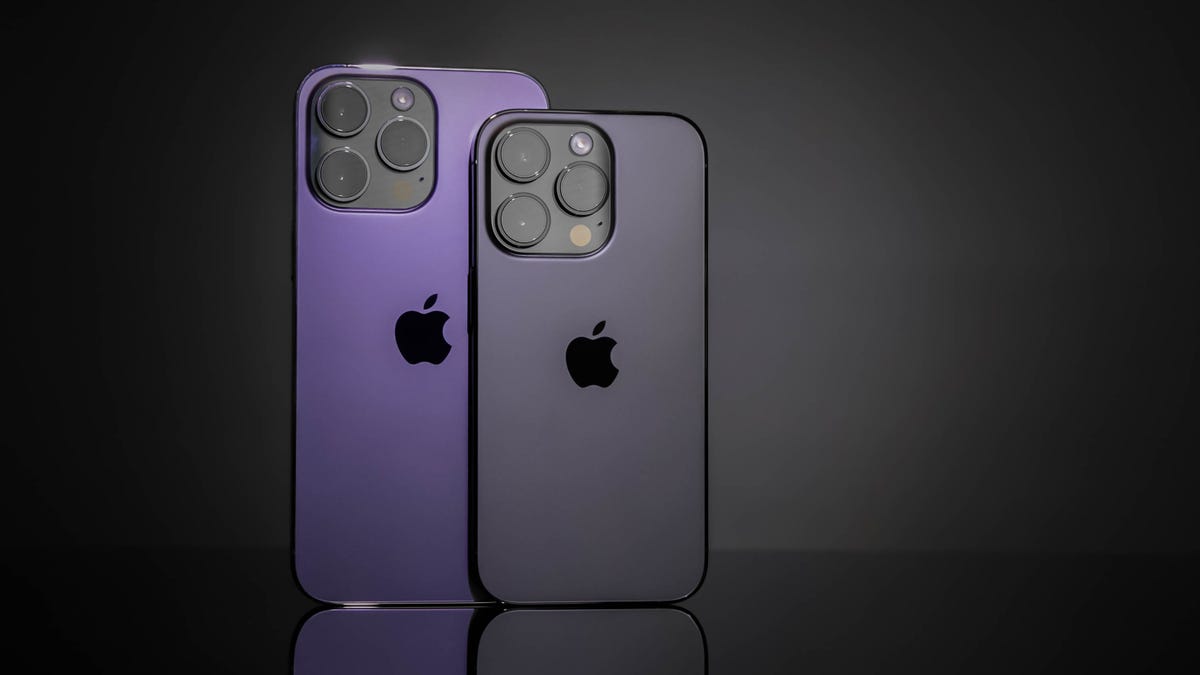
Aside from new colors, it’s hard to tell what’s new about the iPhone 14 Pro and 14 Pro Max from just their backs.
James Martin/CNET
The iPhone 14 Pro’s always-on display is a lot
The iPhone 14 Pro runs on iOS 16, which adds a bunch of welcome features including new ways to customize your lock screen. But there’s one lock screen feature reserved for the 14 Pro and 14 Pro Max: an always-on display.
The always-on display is a low-power version of your lock screen that can show essential information when your phone is locked. Most Android phones have had the feature for years, but Apple’s implementation might be the most gorgeous one yet.

The always-on display is an attractive addition to the iPhone.
Celso Bulgatti/CNET
The 14 Pro’s always-on display shows the time, date, your widgets, notifications and shaded-out version of your lock screen’s wallpaper. Depending on how your lock screen is set up, it can look vastly different when it’s shown as an always-on display. I had fun auditioning different lock screen combinations of wallpaper and widgets to see how they’d look. The color wallpaper is also the biggest difference Apple’s always-on display makes from Android phones, which typically just light up the time and notifications in monochrome.
Seeing my iPhone 14 Pro sitting on a table with its screen on took some getting used to. I kept thinking that I’d forgotten to lock it. To wake, just tap the screen or unlock the phone.
When the 14 Pro is faced down, in a pocket, in a bag or near another Apple device that you’re using, it doesn’t turn on. Also, there’s an option in Settings to turn it off completely.
iPhone 14 Pro, Pro Max Get the Biggest Changes to Apple’s Phone Lineup
I wish there was an option to make the always-on display look more discreet and, for example, just show the time and date. Technically, you could probably set a black wallpaper as your lock screen and only select the date and time for a more minimal always-on display. Visually, the 14 Pro’s always-on display has a lot going on which I found distracting when my phone was face-up next to me.
Taken in total, the Dynamic Island, the new lock screen layout and the always-on display make the 14 Pro the most approachable iPhone for managing alerts and notifications. And I imagine that experience will only get better once live activities for the lock screen in iOS 16 is available in full. (The live activities feature displays real time updates from apps on your lock screen, so you can track the progress of a rideshare or follow the score of a sporting event.)

Look how far the camera lenses on the 14 Pro protrude from its body.
James Martin/CNET
The iPhone 14 Pro camera: It’s 48-megapixel
The iPhone 14 Pro has three rear cameras: a main wide-angle camera, an ultrawide and a telephoto camera with 3x optical zoom. The lens on the main camera has a wider focal length, going from a 26mm equivalent on previous iPhone models to a 24mm one. It’s not drastically different, but it helps get more of the scene into the frame.
The main camera also gets a new larger 48-megapixel sensor. While more megapixels doesn’t necessarily mean better photos, Apple divides the pixels into groups of four and combines them into one larger pixel. The result is a 12-megapixel photo that’s brighter, has less image noise and better detail.

I took this photo just after dusk. Notice how the 14 Pro was able to get a bright exposure without a lot of light.
Patrick Holland/CNET
The main camera takes excellent photos: The image quality and details are great for a phone. I noticed the most improvement is in medium and low-light situations: Colors look good and textures are great. Check out the photo below, which I took on a foggy morning in San Francisco. Notice the textures in the buildings’ bricks and the gradual way the 14 Pro captured the fog engulfing the top of Salesforce Tower.

When I took this photo, there was a lot of fog. Notice the details the 14 Pro was still able to capture.
Patrick Holland/CNET
The photo below was shot under a palm tree’s dark canopy. The 14 Pro did a solid job of capturing the different textures in the leaves and bark while also boosting the brightness.
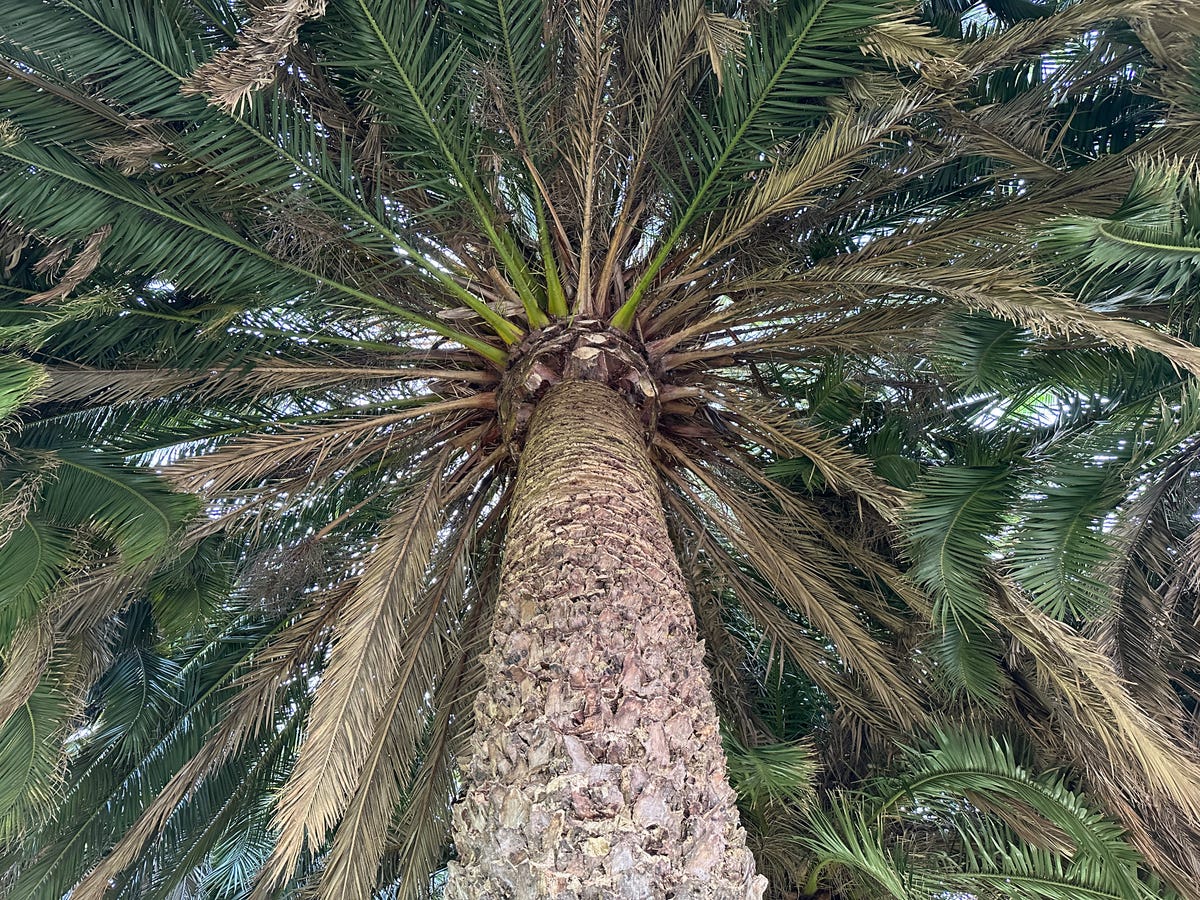
Notice the leaves and bark in particular.
Patrick Holland/CNET
If you’re so inclined, you can capture 48-megapixel photos using the phone’s ProRaw setting. I should warn you that these files are big. The file for the photo below of the Bay Bridge at sunset is 48 megabytes. After editing, the photo is saved as a much smaller JPEG. Look closely at the details of the cars and the bridge’s support cables.

This photo was taken with the full 48-megapixel resolution of the main camera’s sensor and saved as an Apple ProRaw file.
Patrick Holland/CNET
The ultrawide camera gets a new sensor with more focus pixels and a stepped-down f2.2 aperture lens. All this adds up to much sharper ultrawide photos. The sensor — combined with Apple’s revamped photo processing, which it calls the Photonic Engine — gives you much better photos in less ideal situations.
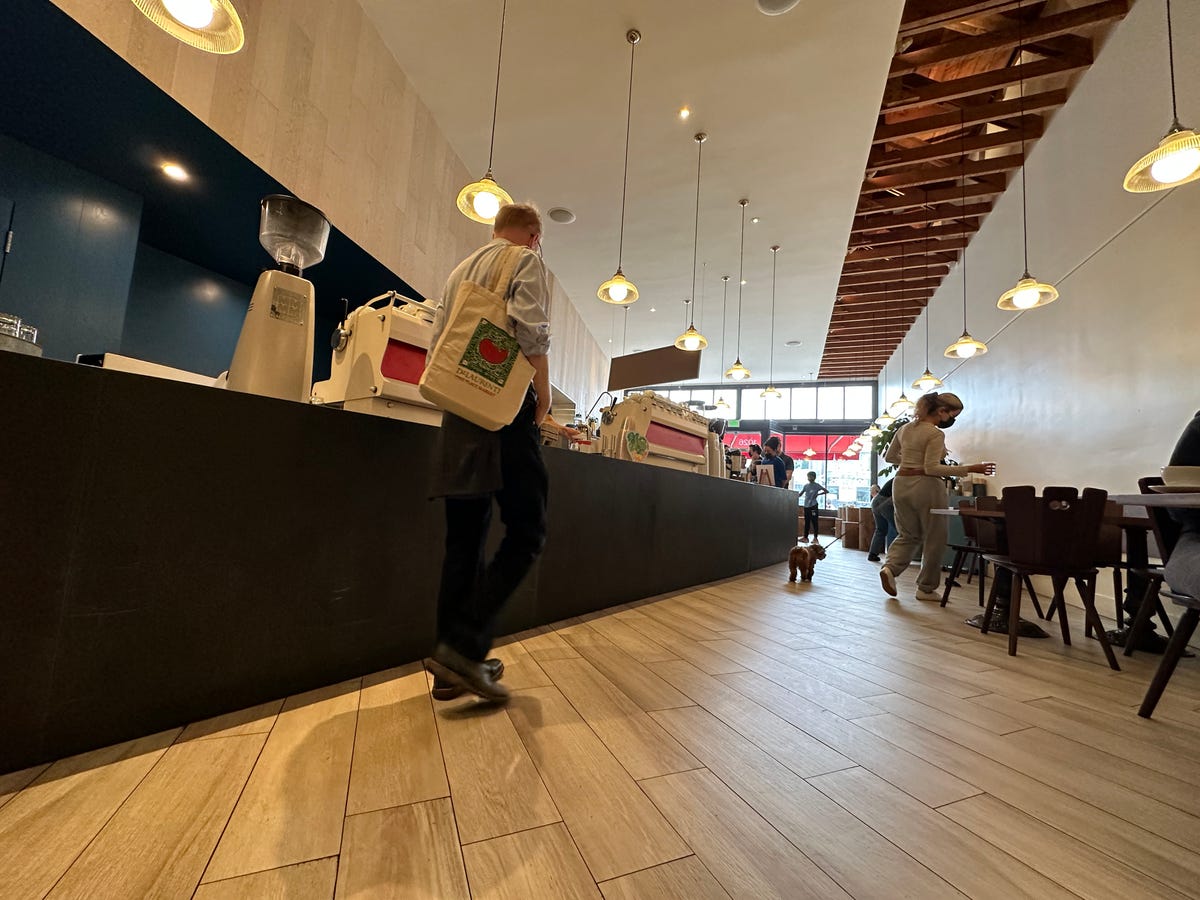
I like how dramatic the ultrawide camera made this man walking toward a coffee counter look.
Patrick Holland/CNET
Ultrawide photos and videos are still a step down compared to those from the main camera, but these improvements are welcomed.
Macro photos also get a boost. When you try to take a photo with the main camera when standing close to a subject, the iPhone 14 Pro switches to the ultrawide camera and crops the framing to mimic the main camera. This allows for a closer focus, which is great for close-up shots of small things. Last year’s 13 Pro had a similar feature, but with the new ultrawide, macro photos have better image quality, especially in medium and low light.

Macro mode lets you get within inches of your subject and have it be in focus, like this Lego car.
Patrick Holland/CNET
The telephoto camera is basically identical to the one on last year’s 13 Pro, but gets a lift from the 14 Pro’s Photonic Engine processing. As with the ultrawide, image quality is a step behind the main camera — especially in dimmer environments.

I took this photo of the Embarcadero in San Francisco during blue hour with the 14 Pro’s telephoto camera.
Patrick Holland/CNET
The TrueDepth camera got an upgraded lens with a brighter f1.9 aperture. And the selfie camera has autofocus for the first time ever, which works great for group selfies. Here are some more photos that I took with the iPhone 14 Pro and 14 Pro Max.

The front-facing camera now has autofocus.
Patrick Holland/CNET

Indoor shots under mixed lighting usually look good.
Patrick Holland/CNET

Another macro photo from the 14 Pro.
Patrick Holland/CNET

This bar was pretty dark, but look closely at the details in the signs and people’s skin tones.
Patrick Holland/CNET
Cinematic mode can now record in 4K and at 24 frames per second. There’s a new video image stabilization tool called Action mode. When you shoot a video you can toggle it on and the phone crops in a bit to keep the image centered and the horizon level. If you’re shooting in 4K, Action mode drops the resolution to 2.8K but the results are still impressive. While other phones, like the Galaxy S22 Ultra, have similar stabilization functions, it’s wonderful to see the tool come to the iPhone. And it works across all three rear cameras.
While testing video shot with and without Action mode, I was reminded how good the image stabilization is in regular video mode. Check out my review video, embedded up top, to see the clips I shot with the iPhone 14 Pro and 14 Pro Max.
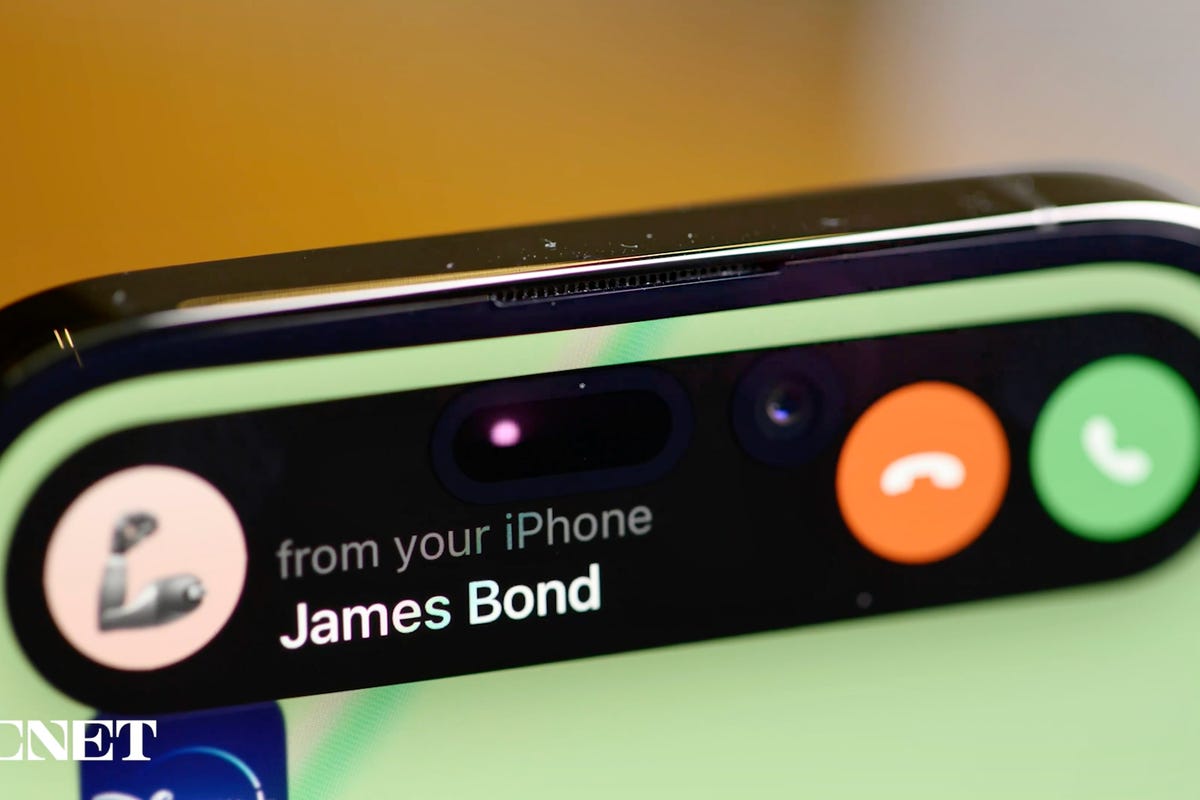
System animations like the ones for the Dynamic Island are super smooth.
Celso Bulgatti/CNET
The iPhone 14 and its A16 Bionic efficiency
Driving all these upgrades is Apple’s new A16 Bionic chip. In use, everything feels peppy. Gaming is an absolute delight. And subtle things, like animations as you move in and out of the Dynamic Island, are super smooth. In our benchmark tests, the iPhone 14 Pro and 14 Pro Max proved that they’re not only faster than any iPhone we’ve ever tested, but they’re the fastest phones you can buy today.
Check out our benchmark test results below.
Geekbench V.5.0 single-core
Note:
Longer bars indicate better performance
Geekbench V.5.0 multicore
Note:
Longer bars indicate better performance
3DMark Wildlife Extreme
Note:
Longer bars indicate better performance
The regular 14 Pro’s battery had no problem making it through a day. I typically got 6 hours of screen-on time. With the 14 Pro Max, I was able to consistently get a day and a half on a single charge.
Charging is OK. I charged the 14 Pro Max for 30 minutes and the battery went from 14% to 59%. The 14 Pro went from 51% to 84%.
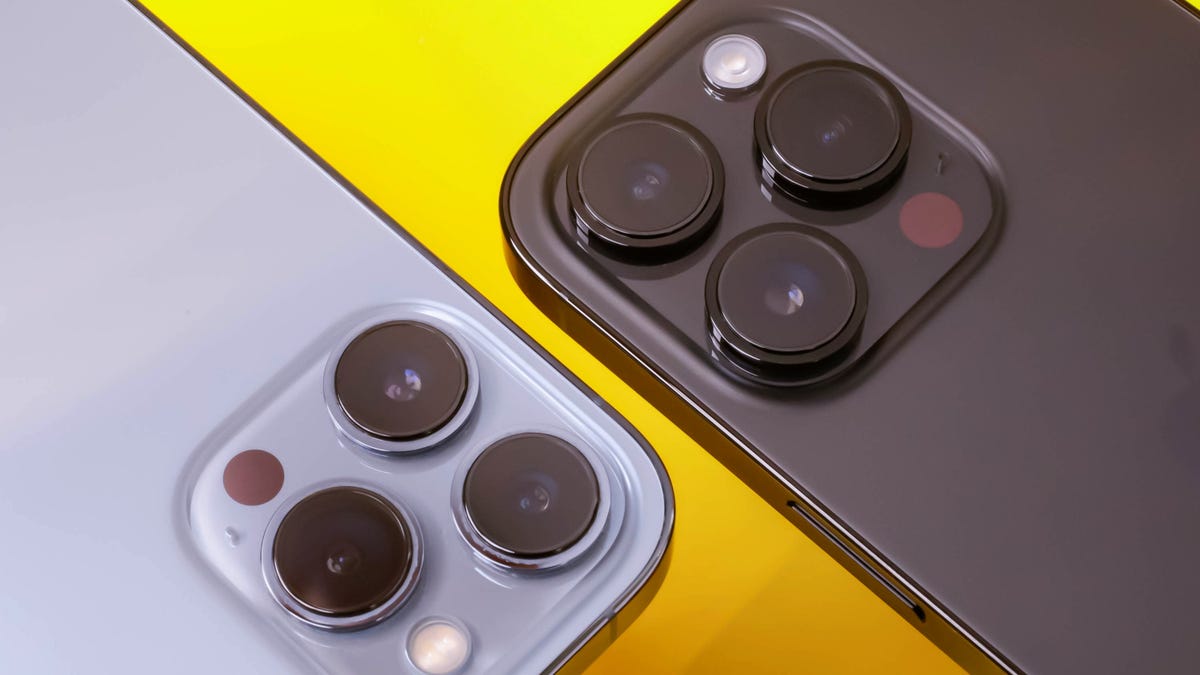
On the left is the iPhone 13 Pro and on the right the new iPhone 14 Pro.
James Martin/CNET
iPhone 14 Pro vs. iPhone 13 Pro, 12 Pro, 11 Pro
If you have last year’s iPhone 13 Pro, I don’t think you should upgrade. While the improvements and new features have a lot of sizzle, you aren’t getting a drastically different experience. Upgrade your 13 Pro to iOS 16 and enjoy the new features from that software update instead.
But if you have an iPhone 12 Pro and have the itch to upgrade, the 14 Pro is a sizable step up in terms of performance, battery life, camera quality and additional features like the Dynamic Island.
And if you’re rocking an iPhone 11 Pro or older, the iPhone 14 Pro is a giant upgrade all around.
iPhone 14 specs vs. iPhone 14 Plus, 14 Pro, 14 Pro Max
| iPhone 14 | iPhone 14 Plus | iPhone 14 Pro | iPhone 14 Pro Max | |
|---|---|---|---|---|
| Display size, resolution | 6.1-inch OLED; 2,532×1,170 pixels | 6.7-inch OLED; 2,778×1,284 pixels | 6.1-inch Super Retina XDR, OLED display, 2,556×1,179 pixels | 6.7-inch Super Retina XDR, OLED display, 2,796×1,290 pixels |
| Pixel density | 460 ppi | 458 ppi | 460 ppi | 460 ppi |
| Dimensions (Inches) | 5.78 x 2.82 x 0.31 in. | 6.33 x 3.07 x 0.31 in. | 5.81 x 2.81 x 0.31 in. | 6.33 x 3.05 x 0.31 in. |
| Dimensions (Millimeters) | 147 x 72 x 7.8mm | 161 x 78 x 7.8mm | 147.5 x 71.5 x 7.85mm | 160.7 x 77.6 x 7.85mm |
| Weight (Ounces, Grams) | 6.07 oz.; 172g | 7.16 oz.; 203g | 7.27 oz.; 206g | 8.47 oz.; 240g |
| Mobile software | iOS 16 | iOS 16 | iOS 16 | iOS 16 |
| Rear cameras | 12MP (wide), 12MP (ultrawide) | 12MP (wide), 12MP (ultrawide) | 48MP (wide), 12MP (ultrawide), 12MP (telephoto) | 48MP (wide), 12MP (ultrawide), 12MP (telephoto) |
| Front-facing camera | 12-megapixel | 12-megapixel | 12-megapixel | 12-megapixel |
| Video capture | HDR video recording with Dolby Vision up to 4K at 60 fps | HDR video recording with Dolby Vision up to 4K at 60 fps | HDR video recording with Dolby Vision up to 4K at 60 fps | HDR video recording with Dolby Vision up to 4K at 60 fps |
| Processor | Apple A15 Bionic | Apple A15 Bionic | Apple A16 Bionic | Apple A16 Bionic |
| Storage | 128GB, 256GB, 512GB | 128GB, 256GB, 512GB | 128GB, 256GB, 512GB, 1TB | 128GB, 256GB, 512GB, 1TB |
| RAM | Undisclosed | Undisclosed | Undisclosed | Undisclosed |
| Expandable storage | No | No | No | No |
| Battery | Undisclosed; Apple lists 20 hours of video playback | Undisclosed; Apple lists 26 hours of video playback | Undisclosed; Apple lists 29 hours of video playback | Undisclosed; Apple lists 29 hours of video playback |
| Fingerprint sensor | No (Face ID) | No (Face ID) | No (Face ID) | No (Face ID) |
| Connector | Lightning | Lightning | Lightning | Lightning |
| Headphone jack | No | No | No | No |
| Special features | 5G enabled; MagSafe; water resistant (IP68); wireless charging; dual-SIM capabilities (e-SIM) | 5G enabled; MagSafe; water resistant (IP68); wireless charging; dual-SIM capabilities (e-SIM) | Dynamic Island; Always-On display; 5G enabled; MagSafe; water resistant (IP68); wireless charging; dual-SIM capabilities (e-SIM) | Dynamic Island; Always-On display; 5G enabled; MagSafe; water resistant (IP68); wireless charging; dual-SIM capabilities (e-SIM) |
| Price off-contract (USD) | $799 (128GB), $899 (256GB), $1,099 (512GB) | $899 (128GB), $999 (256GB), $1,199 (512GB) | $999 (128GB), $1,099 (256GB), $1,299 (512GB), $1,499 (1TB) | $1,099 (128GB), $1,199 (256GB), $1,399 (512GB), $1,599 (1TB) |
| Price (GBP) | £849 (128GB) | £949 (128GB) | £1,099 (128GB) | £1,199 (128GB) |
| Price (AUD) | AU$1,399 (128GB) | AU$1,579 (128GB) | AU$1,749 (128GB) | AU$1,899 (128GB) |




